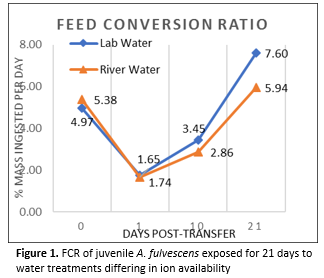DIFFERENCES IN WATER CHEMISTRY BETWEEN HATCHERY AND RIVERINE CONDITIONS IMPACT NUTRIENT ABSORPTION BY JUVENILE LAKE STURGEON
Background:
Extirpated populations of lake sturgeon ( Acipenser fulvescens ) are being reintroduced throughout their range using conservation aquaculture. The differences in environmental factors between the hatchery and the river are predicted to influence growth and survival of stocked juveniles. Furthermore, naturally recruited fish are hypothesized to differ physiologically from hatchery-reared fish due to differences in their developmental environments. Dietary components are known to differ between the feeding strategies employed over the animal's lifespan and ontogenetic changes to digestive processes create survival bottlenecks that occur at feeding transitions associated with life stage. Previous studies indicate that development of lake sturgeon larvae prior to exogenous feeding is determined by water chemistry, but ion uptake is driven by nutritional absorption after the onset of feeding. In juvenile fish, different compositions of ions available for branchial absorption are hypothesized to have an impact on nutrient absorption by the intestine. In this study, growth and nutritional status were compared in juvenile lake sturgeon exposed to either hatchery or riverine conditions.
Methods:
Young-of-year lake sturgeon were provided by the USFWS Warm Springs National Fish Hatchery and exposed for 3 weeks to either dechlorinated tap water or water collected from the Coosa River in two identical temperature-controlled, recirculating tank systems. Anatomical measurements, tissue samples, and digesta were collected at 0, 1, 10, and 21 days from fish (n=5) exposed to each water type. Specific growth rate , condition factor, hepatosomatic index , and survival were quantified. The feed conversion ratio was calculated on a per tank basis to indicate any treatment effects on gastrointestinal absorption rates, and d iet utilization was examined by analysis of proximate composition of the collected intestinal contents, allowing for determination of the nutritional status of juvenile lake sturgeon fed standard commercial feeds (i.e. Rangen , bloodworms).
Results:
The body indexes of sampled fish paired with the feeding data provide a complete picture of the diet utilization of stocking-size lake sturgeon. No differences were observed in growth, condition, SGR, HSI, or gross intestinal anatomy, over the 21-day exposure period. However, treatment differences were observed for feed conversion ratio , with more efficient FCR in river water -exposed fish at 10 and 21 days post- transfer (Fig. 1) . Additionally, the proximate composition of intestinal contents 6 h post-feeding indicated significant differences in nutritional absorption, suggesting that environmental ion availability influences intestinal function.
Conclusions:
This experiment investigated how environmental ion availability influences growth and nutrient absorption of juvenile lake sturgeon. Changes to absorption and nutrient allocation in young-of-year lake sturgeon at stocking may have impacts on their regulatory physiology and impact the survival of fingerlings . Our results indicate that following transfer to Coosa River water, lake sturgeon experienced similar growth but displayed more efficient nutrient use than fish held in laboratory conditions. Analysis of collected gut contents indicates functional changes in nutrient absorption. These results can be utilized to improve procedures to successfully rear and release this protected species into their natural habitat which is imperative to reestablishing the Coosa River lake sturgeon population.
